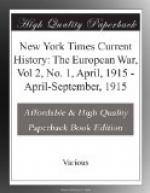Professor Laughlin, who makes the following remarkable study of the German financial emergency, was lecturer on political economy in Berlin on the invitation of the Prussian Cultur Ministerium in 1906, and since 1892 has been head of the Department of Political Economy in the University of Chicago. He is acknowledged to be one of the foremost American economists and the views here expressed are based on wide information.
In a great financial emergency conditions are immediately registered in the monetary and credit mechanism. Although the German Government and the Reichsbank had obviously been preparing for war long before, as soon as mobilization was ordered there was a currency panic. The private banks stopped payment in gold. Crowds then besieged the Reichsbank in order to get its notes converted into gold. Then the Banking act was suspended, so that the Reichsbank and private banks were freed from the obligation to give out gold for notes. At once all notes went to a discount in the shops as compared with gold. Thereupon, in summary fashion, the Military Governor of Berlin declared the notes to be a full legal tender and announced that any shop refusing to take them at par would be punished by confiscation of goods.
In Germany, as is well known, the main currency is supplied by the Reichsbank, covered by at least 33-1/3 per cent. in gold or silver, and the remaining two-thirds by commercial paper. Immediately after the outbreak of war there was a prodigious increase of loans at the Reichsbank, in consequence of which borrowers received notes or deposit accounts. Usually transactions are carried through by use of notes, and not by checks, as with us. On July 23, 1914, the notes stood at $472,500,000; deposits at $236,000,000; discounted bills and advances at $200,000,000. On Aug. 31 notes had increased to $1,058,500,000; deposits to $610,000,000; discounts and advances to $1,113,500,000, (by October this amount was lowered to about $750,000,000.) On the latter date the specie reserve stood at $409,500,000, or more than the legal one-third. Loans had been increased 556 per cent.; notes 223 per cent., and deposits 258 per cent. In short, $586,000,000 of notes had been issued beyond the amount required in normal times, (July 23.) Clearly this additional amount was not required by an increased exchange of goods, but by those persons whose resources were tied up and who needed a means of payment. The same was true of the large increase of deposits which resulted from the larger loans. A liberal policy of discounting was followed by which loans were given on the basis of securities or stocks of goods on hand. That is, non-negotiable assets were converted into a means of payment either in the form of notes or deposit credits.




